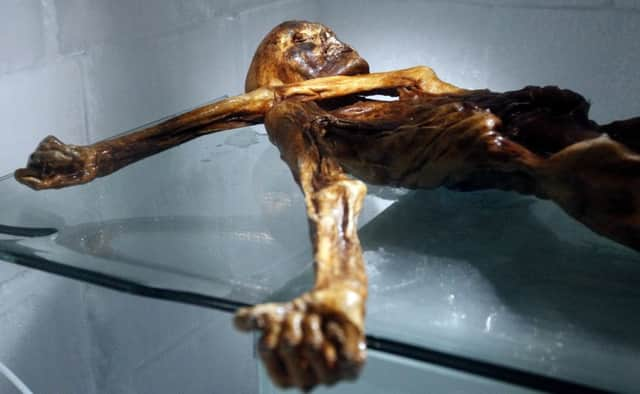Iceman was picky about wardrobe


Other items of his attire were fashioned from domesticated animals, including sheep, goats and cattle.
Experts believe this proves Copper Age people selected species for their particular attributes when it came to manufacturing clothing.
Advertisement
Hide AdAdvertisement
Hide AdScientists have spent the past two decades analysing the remains of a man found in the Tyrolean mountains in 1991.
Known as the Iceman, or Ötzi, he is estimated to have lived in the area between 3359 BC and 3105 BC.
He is Europe’s oldest known natural human mummy and has offered an unprecedented glimpse of Chalcolithic life.
Studies suggest Ötzi was around 45 years old when he died and is most closely related to southern Europeans, especially geographically isolated populations such as Corsicans and Sardinians.
Experts believe he could have been a mountain shepherd, existing on a mixture of meat, grains, roots and fruits.
It is not known for sure how he died but an arrowhead was found lodged in his left shoulder and there was evidence of cuts, bruises and a head injury.
Ötzi’s clothes were sophisticated. He wore a woven grass cloak and a coat, belt, leggings, loincloth and shoes, all made from different skins. He also sported a fur cap.
Amongst his possessions were a copper axe, a flint knife and a quiver of 14 arrows, some with flint tips and fletching.
Advertisement
Hide AdAdvertisement
Hide AdNow the latest genetic testing techniques have allowed researchers to identify the animals used to fashion his gear.
By sequencing the mitochondrial genomes of nine fragments of leather, they found the hat came from brown bear, the leggings from goat and the quiver from roe deer.
The coat was created from a combination of at least four hides from two species – goat and sheep – which suggests a haphazard stitching together of the materials available.
Whilst previous tests have established Ötzi as an agro-pastoralist, existing on a mix of agriculture and livestock herding, lead author Niall O’Sullivan, of University College Dublin and Italy’s Institute for Mummies and the Iceman, believes the hat and quiver provide evidence of hunting and trapping wild animals.
The paper, published in the journal Scientific Reports, states: “Results indicate that the majority of the samples originate from domestic ungulate species (cattle, sheep and goat), whose recovered haplogroups are now at high frequency in today’s domestic populations.
“Intriguingly, the hat and quiver samples were produced from wild species, brown bear and roe deer respectively.
“Combined, these results suggest that Copper Age populations made considered choices of clothing material from both the wild and domestic populations available to them.”